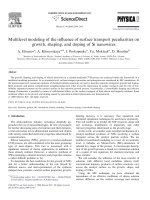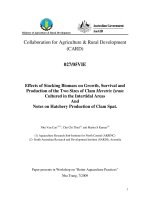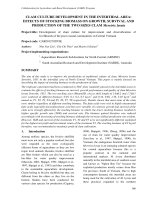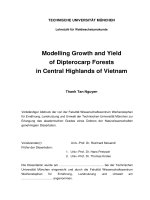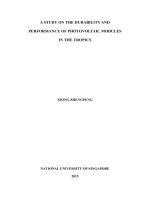Study on growth development and yield of feanut genotypes in the auturm winter cropping season 2020 at gia lam ha noi
Bạn đang xem bản rút gọn của tài liệu. Xem và tải ngay bản đầy đủ của tài liệu tại đây (2.7 MB, 76 trang )
VIETNAM NATIONAL UNIVERSITY OF AGRICULTURE
FACULTY OF AGRONOMY
UNDERGRADUATE THESIS
TITLE: STUDY ON GROWTH, DEVELOPMENT AND
YIELD OF PEANUT GENOTYPES IN THE AUTURM WINTER CROPPING SEASON 2020 AT GIA LAM,
HANOI
Student
: NGUYEN THI PHUONG
ID Code
: 611801
Class
: K61-KHCTT
Supervisor
: PHD. DINH THAI HOANG
Departmen : INDUSTRIAL - MEDICINAL PLANTS SCIENCE
HANOI - 2021
DECLARATION
I declare that the undergrateduate thesis is the result of my research. The
data and result mentioned in this thesis are honest and not used in any published
thesis, dissertations, and scientific research project previously.
I hereby commit that the information cited in the thesis ensuring cited
cited as prescribed. I bear full responsibility for these reassurance.
Hanoi, February 24, 2021
Student
Nguyen Thi Phuong
i
ACKNOWLEDGEMENTS
To complete this thesis, I am deeply indebted to people who have been
providing me with precious support and advice.
Firstly, I would like to send my gratitude to my supervisor, PhD. Dinh
Thai Hoang , Department of Industrial and Medicinal Plants , Faculty of
Agronomy, Vietnam National University of Agriculture, for their enthusiastic
support, helpful advice and considerable encouragement in the completion of my
thesis.
I would also like to express sincere thanks to all the lectures from Faculty
of Agronomy, who taught and created best conditions for students during
learning process and research.
Last but not the least, I would like to thank my family and my friends who
have alwaay beens by my side, give me support and strength to complete this
graduattion thesis.
Hanoi, January 10th , 2021
Student
Nguyen Thi Phuong
ii
CONTENTS
DECLARATION ................................................................................................... i
ACKNOWLEDGEMENTS .................................................................................. ii
CONTENTS ......................................................................................................... iii
LIST OF ABBREVIATIONS ............................................................................... v
LIST OF TABLES ............................................................................................... vi
LIST OF FIGURES .............................................................................................. vi
ABSTRACT ........................................................................................................ vii
CHAPTER 1: INTRODUCTION ......................................................................... 1
1.1. Problem .......................................................................................................... 1
1.2. Objective ........................................................................................................ 2
CHAPTER 2: LITERATURE REVIEW .............................................................. 3
2.1 Peanut production in the World ...................................................................... 3
2.2 Peanut production in the Vietnam ................................................................... 7
2.3. Research situation peanuts genotypes .......................................................... 11
2.3.1. Research situation in the world ................................................................. 11
2.3.2. Research situation in Vietnamese ............................................................. 14
CHAPTER 3: MATERIALS AND METHODS ................................................ 18
3.1 Experimental materials.................................................................................. 18
3.2. Experimental design ..................................................................................... 19
3.3. Crop management ........................................................................................ 19
3.3.1. Land preparation ....................................................................................... 19
3.3.2. Seed preparation and sowing .................................................................... 20
3.3.3. Fertilize...................................................................................................... 20
3.3.4. Density, distance ....................................................................................... 20
3.4. Research content .......................................................................................... 21
3.4.1. Experiment layout ..................................................................................... 21
3.4.2. Growth and development indicators ......................................................... 22
iii
3.4.3. Data analysis ............................................................................................. 25
CHAPTER 4. RESULTS AND DISCUSSION .................................................. 26
4.1. Morphological characteristics of the peanuts genotypes in aurtum winter season 2020 .................................................................................. 26
4.1.1. Mophological characteristic of peanuts genotypes ................................... 26
4.1.2 Germination rate, growth duration of groundnut genotypes ...................... 32
4.1.3. Growth main stem and dynamic of primary branches of groudnuts
genotypes................................................................................................. 38
4.1.4. Growth dynamics of primary branch length of peanuts genotypes .......... 41
4.1.5. Leaf area (LA) and leaf area index (LAI) of peanut genotypes ................ 43
4.1.6. Nodutation ability...................................................................................... 45
4.2. The level of infection with some major diseases of peanut genotypes
tested in the Autumn-Winter crop 2020.................................................. 47
4.3. Yield and yield component of peanuts genotypes in the Autumn-Winter
crop 2020 ................................................................................................. 51
4.3.1. Yield component in experimental of peanut genotypes ............................ 51
4.3.2. Harvest index and yield of peanut genotypes ........................................... 56
CHAPER 5. CONCLUSIONS AND SUGGESTIONS ...................................... 61
5.1. Conclusions .................................................................................................. 61
5.2. Suggestion .................................................................................................... 61
REFERENCES1 .................................................................................................. 63
APPENDIX ......................................................................................................... 65
iv
LIST OF ABBREVIATIONS
FAO
: Food and Agriculture Organization of the United Nations
FAOSTAT
: Food and Agriculture Organization Corporate Statistical
Database
ICRISAT
: International Crops Research Institute for the Semi-Arid
Tropics
LA
: Leaf area
LAI
: Leaf area index
P100 Seed
: Weight of 100 pod
P100 Seed
: Weight of 100 seed
v
LIST OF TABLES
Table 2.1 Area, yield & productivity peanuts some number of countries in
the world 2018-2019 ................................................................................. 3
Table 2.2 Production of peanuts in continents of the world (2017 – 2018) ......... 5
Table 2.3 Productivity Peanuts of Vietnamese(2010-2019) ................................. 8
Table 2.4: Area, yield of peanuts in some provinces and cities of Vietnam in
2015 ......................................................................................................... 10
Table 3.1: The investigated peanut genotypesnt ................................................. 18
Table 4.1. Mophological characteristic of peanuts genotypes ............................ 27
Table 4.2 Color of mature uncured testa of peanuts genotypes .......................... 31
Table 4.3. Germination rate, growth duration of groundnut genotypes ............. 33
Table 4. 4 Dynamic main sterm height of peanuts genotyppes .......................... 39
Table 4.5. Growth dynamics of primary branch length of peanuts genotypes ... 41
Table 4.6. Leaf area, leaf area index of peanuts genotypes ................................ 44
Table 4.7 Nodutation of peanut genotypes ......................................................... 46
Table 4.8: Pest and disease infection level of peanut genotypes ........................ 48
Table 4.9. Factors constituting the yield of peanuts genotypes .......................... 52
Table 4.10. Harvest index and yield of peanut genotypes .................................. 56
vi
LIST OF FIGURES
Figure 2.1 Area & productivity of peanuts in the world 2015-2019 .................. 4
Figure 4.1: Maine stem height dynamic of peanut genotypes ............................ 40
Figure 4.2 Growth dynamics of primary branch of peanut genotypes ............... 42
vii
ABSTRACT
This experiment was conducted to evaluate the growth and development
of 78 peanuts genotypes with different traits associated with fresh yield and
quality of peanuts genotypes in Autumn-Winter 2020, we grew 78 genotypes
obtained from the Department of Industrial and Medicinal Plants, Faculty of
Agronomy, Vietnam National University of Agriculture. Layout in a
randomized complete block design with L27 control varieties.
The goal is to evaluate peanut varieties in the autumn-winter crop of
2020, compare growth and development, yield and yield factors and effects of
pests and diseases on peanuts. from which it is possible to propose some peanut
varieties to be tested.
In the crop year 2020, we are planting seedlings to monitor the growth
and development of the experiment. By the time of harvesting the nodes, we
measure the indicators of yield and yield, pests and diseases after the evaluation
process, we have the following results: genotypes have different growth times
(115-120 days). varieties have different factors for productivity and yield. The
number of fruits/plant with the highest number is G16 (15 fruits/plant), G16 has
the highest number of firm fruits/plant, reaching 11 fruits/plant... After
evaluating all the same lines we get It was found that H1 was a breed that had
higher yield, yield and higher than that of the control L27.
viii
CHAPTER 1: INTRODUCTION
1.1. Problem
Peanut (Arachis hypogaea L.) is a short-term industrial plant, a food crop
of high nutritional and economic value that is increasingly grown in popularity
in many countries around the world originating from Central and South
America. Peanut not only provide food for humans, feed for livestock but also
are an important source of raw materials for many processing industries. Among
the short-day oil crops, peanuts ranked 2nd after soybeans in terms of area and
yield, 13th in food crops, 4th in vegetable oil sources and 3rd for crops protein
supply. Peanut an important role in the life and economy of many countries
around the world. Peanut contains 40-60% lipids, 26 - 34% protein, 8 types of
non-substitute amino acids and many vitamins such as PP, B, E, F, especially
vitamins B1, B2 and B3. In addition, the peanut root system also has nodules
caused by symbiotic Rhizobium vigna bacteria, which helps peanuts become
plants capable of maintaining and improving soil fertility, increasing land use
coefficients and economic efficiency per unit area. Therefore, peanuts are an
important crop in an intercropping system with other crops.
However, peanut production in Vietnam is currently facing many
difficulties, nutritional low quality and yield, not competitive with other markets
in the world, especially the Chinese market. The reason for the slow
development of peanut production in Vietnam is the impact of many factors, one
of which is the lack of good seed. Therefore, the research on selecting and
breeding peanuts with high yield, good quality, adaptability to adverse
conditions and resistance to pests and diseases has been and is a top concern. So
that, scientists and breeders are studying to produce new varieties that has high
productivity, quality, adaptability, and pest resistance.
1
Therefore, to contribute to solving the above problem, we carried out the
subject “Study on growth, development and yield of peanut genotypes in the
auturm - winter cropping season 2020 at Gia Lam, Hanoi”.
1.2. Objective
Aims
To evaluate growth, development and yield of peanut genotypes to
suggest the best genotypes for peanut production in autumn/winter season at Gia
Lam, Hanoi.
Requirements
Identify the morphological characteristics of investigated peanut
genotypes;
Evaluate the ability of growth and development of peanut genotypes in
Autumn - Winter season 2020 at Gia Lam, Hanoi;
Assess the pests and diseases infection ratios of peanut genotypes in
autumn – Winter season 2020 at Gia Lam, Hanoi;
Identify the components of productivity and yield of peanut varieties in
Autumn-Winter crop 2020 in Gia Lam, Hanoi.
Proposing some peanut genotypes with high yield for next breeding in the
next years and conform with land at Trau Quy, Gia Lam, Ha Noi
2
CHAPTER 2: LITERATURE REVIEW
2.1 Peanut production in the World
Peanut appearing for a long time, but althrought the economic role of the
plant has only been determined over the past 100 years. In the middle of the 18th
century, World production of peanut was only self-sufficient for each region.
But so far, the use the demand for peanuts and consumption, the market outlook
for peanuts is also very positive. This is an opportunity to push countries to
invest in developing peanut production on an increasing basis, not only in terms
of production area but also in terms of productivity and output of the world are
also improving. Currently, peanuts ranked 2 in terms of area and yield after
soybeans and are grown in 115 countries around the world with an area of more
than 27 million hectares.
Table 2.1 Area, yield & productivity peanuts some number of countries in
the world 2018-2019
Countries
Area
Yield
Productivity
(million ha)
(tons/ha)
(million tons)
2018
2019
2018
2019
2018
2019
China
4.6
4.5
3.7
3.9
17.4
17.6
India
4.9
4.7
1.9
1.4
9.3
6.7
America
0.6
0.6
4.4
4.4
2.5
2.5
Indonesia
0.4
0.3
0.1
0.1
0.4
0.3
Argentina
0.5
0.4
2.1
3.5
0.9
1.3
Nigeria
3.8
3.9
1.2
1.1
4.6
4.5
Pakistan
0.09
0.1
1
0.9
0.09
0.09
World
29.7
29.6
1.7
1.6
50.9
48.8
Source: Faostat. 2021
3
Figure 2.1 Area & productivity of peanuts in the world
2015-2019
According to FAO (2021), up to 2019 the area, productivity and yield in
the world tend to decrease compared to 2018.
Area: in 2019, the world peanut cultivated area was 29,5 million hectares,
a decrease of 0,1 million hectares compared to 2018. Countries with the largest
peanut cultivation area are India (4,7 million ha), China (4,5 million ha), Nigeria
(3,9 million ha), USA (0,6 million ha), Indonesia (0,3 million ha), Argentina
(0,4 million ha), Pakistan (0,1 million ha). The leading countries in peanut yield
all saw a slight decrease in area in 2019, specifically India with an decrease of
0,5 ton/ha, down 25% compared with 2018.
Yeild: The average peanut yield in the world is still low. In 2019, peanut
yield was 1,6 tons/ha, an decrease of 5,8% compared to 2018, There is a big
difference between peanut yield of countries around the world, Peanut yield in
each region and country has different variations depending on production scale,
ecological conditions and farming level. In the USA, the yield in 2019 was 4,4
tons/ha, much higher than other countries and the average yield worldwide,
compared to 2018, the USA had peanuut yield not change and and Indonesia
same that, However, China (3,7-3,9) and Argentina(2,1-3,5) had peanut yield
4
increase compared with 2018.
Productivity: Peanut production in 2019 tends to decrease compared to
2018. World peanut productivity is 48,8 million tons, down 4,2% compared to
2018. Countries with increased production are China 17,6 million tons, up
1,14%, Argentina 1,3 million tons up 44,4%, Countries with decreased
production are India 6,7 million tons reduce 26,8%, Indonesia 0,3 million tons,
25%, Pakistan 0,8 and USA 2,5 no increase compared with 2018..
Around the world, peanuts are distributed concentrated in the tropics and
subtropics, between 40° North and 40° South (Hau et al., 1995). The world's
peanut production can be divided into six main regions: America, Africa, Asia,
sub-East Asia, Europe and the Pacific. Large regions are divided into small
regions. peanut production in every continent, every country and every region
has changed over time. The area, production, and yield of peanuts between
regions did not change much. Many areas peanuts are small but the yield is
relatively high. Meanwhile, many regions have large area but the yield is very
low. To clearly see the entire peanut production of each continent, the data in the
following table can satisfy.
Table 2.2 Production of peanuts in continents of the world (2017 – 2018)
Continent
Area
Yield
quantity
(million ha)
(tons/ha)
(million tons)
2017
2018
2017
2018
2017
2018
Africa
15.3
15.7
8.2
9.1
12.6
14.3
Asia
11.5
11.5
25.8
23.7
29.5
27.2
Europe
0.002
0.002
27.8
26.6
0.006
0.005
Americas
1.4
1.4
36.6
32.0
5.3
4.4
Australia
0.01
0.01
19.5
20.1
0.02
0.02
World
28.2
28.5
16.8
16.1
47.4
45.9
Source: FAOSTAT. 2020
5
Data number from table 2.2 to be output at the conyinent in the world.
Africa is the continent with the largest cultivated area in the world. the
cultivated area is 15.7 million hectares (2018), an increase of 1.02 times
compared to 2017 (15.3 million hectares). Lost in Africa uses 54% to 55% of the
world. Although Africa has a large production area (more than Asia). the energy
tribe of Africa is very low. The Slow Growth Yield. in 2017 the yield was only
8.2 quintals/ha. By 2018, productivity increased but increased very slowly by
9.1 quintal/ha, productivity was much lower than the average capacity of the
world and this is the continent with the lowest productivity in the world. The
number of African peanuts in 2 years varied from 12.60 to 14.3 million tons.
Lately two years, Asia is the continent largest peanuts growing area in the
world (after Africa). Asia has accounted for about 40% of the world's. The area,
from 2017 to 2018 this continent has slightly increased, fluctuations from 11.5
to 11.5 million hectares. Asian peanut yield has not been stable in the last 2
years, 2017-2018 yield decreased to only 23.7 quintals/ha. Due to the decrease
in productivity. Asian peanut production also decreased from 29.5 million tons
(2017) to 27.2 million tons in 2018 (reduce 1.1 times compared to 2017). Asia's
peanut production accounts for about 62% of the world's.
The Americas account for only about 5% of the world area. accounting
for 10 to 11% peanut production of the world's. In 2 years, the Americas peanut
production was quite stable in terms of area (over 1 million ha). although the
cultivated area is small. The Americas are the continent with the largest yield in
the world in 2017 the yield of peanuts. The Americas reached 36.6 quintals/ha
by 2018 it would decrease to 32.0 quintals/ha. Production reached 5.3 tons in
2017 but reduced by 1.2 times from 2017 to 2018 to 4.4 million tons (2018).
Europe and Australia have a very small area. Only 0.04% to 0.05% of the
world area. Production accounts for 0.05% to 0.06% production of the world.
6
The yield of peanuts in these two continents has increased and Europe has not
increased significantly Australia also increased 1.1 times.
In general in the last two years (2017 - 2018), the peanut cultivated area in
continents increased slightly (except the Americas and Australia), peanut
production in the continents reached the highest level in terms of area, yield and
productivity in 2017.
The application of scientific and technical advances and new breeding
activities in production suitable to each ecological condition of the regions is
very necessary, it contributes to increase productivity and yield of Peanuts to
meet the market demand.
2.2 Peanut production in the Vietnam
In Vietnam, peanuts are a leading industrial crop. Peanut has been grown
for a long time in many different soil types, widely distributed from latitude 36°
North to latitude 36° South. Peanuts can adapt tropical hot-humid and hot-dry to
the tropical rainy and relatively humid.
Before the period of natioIn Vietnam, peanuts are a leading industrial
crop. Peanut has been grown for a long time in many different soil types, widely
distributed from latitude 36° North to latitude 36° South. Peanuts can adapt
tropical
honal
renewal.
Vietnam's
agriculture
was
backward
and
underdeveloped, It was also a country with a lack of food, most of the area under
annual crops cultivation focused on growing food crops. Therefore, the area of
peanuts has not been focused, productivity and output are low, Since the
implementation of the country's renewal especially the renovation of agricultural
development policies. The restructuring of crops to increase income on the
cultivated area peanuts are more interested in developing.
After the period of national renewal especially the reform of agricultural
development policies. The restructuring of crops to increase income on the
cultivated area peanuts are more interested in developing. According to Nguyen
7
Huu Quan (1961) In 1932 the peanut area of Vietnam was only 3800ha. After
peace was repeated in the North the government paid attention to facilitate the
growth of the peanut. So in 1961, the area of growing peanuts in the North was
about 30000 ha with an output of approximately 30000 tons of peanuts.
In recent years, with the attention and direction of the Party and the State
on the transformation of crop structure, production towards commodity
products, peanut production in Vietnam has tended to increase both in acreage,
productivity and yield.
Table 2.3 Productivity Peanuts of Vietnamese(2010-2019)
Area
Yield
Productivity
(thousand ha)
(quintal/ha)
(thousand ton)
2010
231.4
21.1
487.2
2011
223.8
20.9
468.7
2012
219.2
21.4
468.5
2013
216.4
22.7
491.9
2014
208.7
21.7
453.3
2015
200.2
22.7
454.1
2016
184.8
23.1
427.2
2017
195.6
23.5
459.6
2018
185.7
24.7
458.7
2019
177.0
24.8
438.9
Year
Souce: General Statistics Office. 2021
8
The data table shows, the peanut cultivated area from 2010 to 2019, the
area of peanuts in the whole country tended to decrease from 231.4 thousand
hectares to 177.0 thousand hectares. By 2017, the peanut area increased by 10.8
thousand hectares, then decreased to only 185.7 thousand hectares in 2018 and
177 thousand hectares in 2019.
Productivity and yield of peanuts in our country have changed. Although
the cultivated area of peanuts decreased, peanut yield increased slightly over the
years. The lowest was 2010 and 2011 reaching only 20.9 quintals/ha. In 2018,
peanut yield was the highest at 24.7 quintal/ha. Due to the rapid decrease in area,
yield increased but not significantly, leading to peanut productivity in the period
from in 2010 - 2019 decreased from 487.2 thousand tons to 438.9 thousand tons.
Currently, the main peanut production regions of Vietnam include 6
regions: Southeast, Red River Delta, Mekong River Delta, Northeast, Northwest,
North Central Coast, South Central Coast, Central Highlands.
The Central Coast is the region with the largest peanut cultivation area in
the country, with an area of 88.6 thousand ha (accounting for 42.5% of the
national area). The Mekong River Delta is the region with the highest
productivity of 37.8 quintals/ha. From a local perspective, the provinces with
peanut areas over 8.000 ha/year or more are Bac Giang, Thanh Hoa, Nghe An,
Ha Tinh, Quang Nam, Binh Dinh, Some localities with a peanut yield many
times higher than the national average yield are: Nam Dinh - 37.0 quintal/ha,
Long An - 31.5 quintal/ha, Tay Ninh - 34.9 quintal/ha, Binh Dinh - 29.8
quintal/ha, Tuyen Quang - 26.3 quintal/ha.
According to Vu Dinh Chinh (2008), peanuts in Vietnam can be divided
into regions: Red River Delta (11 provinces), Northeast (11 provinces),
Northwest (4 provinces), North Central Coast (6 provinces), South Central Coast
(6 provinces), Mekong River Delta (5 provinces) and Southeast (8 provinces).
9
Table 2.4: Area, yield of peanuts in some provinces and cities of Vietnam in
2015
Area
Productivity
(Thousand ha)
(Thousand ton)
Country
195.3
459.8
Ha Noi
3.8
8.8
Phu Tho
4.3
8.3
Vinh Phuc
3.0
5.7
Bac giang
11.7
28.9
Ha Giang
8.6
18.1
Thanh Hoa
12.8
23.6
Nghe An
16.2
37.3
Ha Tinh
16.0
36.9
Quang Binh
4.0
8.0
Quang Nam
9.7
19.1
Binh Dinh
8.7
27.8
Đak lak
7.2
8.8
Tay Ninh
5.9
20.9
Long An
6.0
20.3
Province, cities
Souce: General Statistics Office, 2015
Table 2.5 shows that peanuts are grown mainly in the Northern provinces,
including the Red River Delta, Northeast, Northwest, North Central. In which,
the North Central region is the region with the largest peanut cultivation area.
Red River Delta region: peanuts are grown mainly in Hanoi (3.8 thousand
hectares), Vinh Phuc (3.0 thousand hectares). In 2015, peanut yield in Hanoi
was 8.8 thousand tons and in Vinh Phuc it was 5.7 thousand tons.
10
The Northern Midlands and Mountains: peanuts are grown mainly in Ha
Giang (8.6 thousand hectares), Phu Tho (4.3 thousand hectares).
North Central Region and Central Coast: This is the key peanut
production region because the region has the largest area and production in the
country. Peanuts are grown concentrated in Nghe An, Ha Tinh, Thanh Hoa,
Quang Nam... in which Nghe An has the highest area of 16.2 thousand hectares
(2015).
Our country's peanut yield is much lower than that of other countries in
the world. The reason is that our country does not have a variety suitable for
each region, production on a small scale, no planning for growing areas, local
varieties are easy to mix, degenerate and outdated production techniques. The
top task of our country peanut breeder is to urgently choose and create new
varieties that grow, develop well, have high productivity, good quality and are
suitable for each growing region. Currently, a number of new peanut varieties
have high yield potential such as 1660, LVT, LO2, VD1, LO5, short-term,
drought-tolerant, serving the sky with good yield (18-25 quintals/ha) has been
put into production. Some methods of intensive peanut cultivation have also
been applied, such as balanced NPK fertilizer, appropriate sowing density, and
nylon covering techniques, which has increased yield by 35-40%. Many models
of intensive peanut cultivation with high yield of over 3 tons/ha have been
demonstrated in farmer fields in many localities (Dan et al., 2000).
2.3. Research situation peanuts genotypes
2.3.1. Research situation in the world
In order to serve of peanut breeding, the collection, evaluation and
preservation of genetic resources of peanuts have been well implemented by
many organizations and countries around the world. Thanks to the collection,
evaluation and preservation of good genetic resources, breeders have chosen to
create many varieties with high yield, good quality, short growth time, resistance
11
to pests and diseases, wide adaptation to cashew. External events ... have
significantly contributed to increased productivity and production of peanuts in
the world.
About the collective peanut seed: Currently, the US is the country with
the richest peanut group, with 29,000 seed samples stored and preserved in
many different forms (in-situ and ex-situ). Next is the International Semi-arid
Tropical Plant Research Institute (ICRISAT), which holds about 14,310
different varieties, collected from 92 countries around the world; Australia is
also a country with a diversified peanut group (12,160 seed samples). India and
China still maintain every year from 5,000 to 6,000 varieties.
About the peanut breeding method: The main new methods of peanut
breeding and breeding are currently popularly used in countries around the
world, but still selective imported, sexual and mutant hybridization. Recently, in
China, the research has begun to improve the resistant varieties of the leaf curl
virus by using the resistant gene transfer method, the initial results show positive
results. In the US and ICRISAT have researched to use cell technology and
molecular indicator techniques to select peanuts that are resistant to leaf disease,
bacterial wilt and drought.
Some results of peanut breeding and breeding in the world: From a
diverse and abundant source of materials, by major methods of breeding,
breeders have used them in breeding improvement according to other goals each
other such as: selecting and breeding early ripening varieties for growing crops,
avoiding natural disasters; drought-tolerant varieties for the sky; pest resistant
varieties; high yielding varieties; varieties with high oil content, varieties with
thin pods, varieties with high protein content in the stem ... In that direction,
some peanut varieties yield Ca-4, Luhua 9, Luhua 14, Luhua 7 8130 ,. .. has
yield potential of over 75.0 quintal/ha, good quality varieties like Baisha 1016,
Hua 17, Hua 10, Luhua 10, ... varieties resistant to blight and rust like Zhonghua
12
2, Zhonghua 4, Yueyou92,.. All peanut cultivars grown in China are hybrids,
bred at research institutes and universities (Shuren et al., 1996).
India has also made great achievements in breeding. By way of
ICRISAT's peanut trials, India has isolated and developed BSR's early ripening
peanut variety which is widely served in production (Sudhakar et al., 1995).
In the International Crop Study for the Semi-Arid Tropical Region
(ICRISAT) Hyderabat, India specified the collection, evaluation, storage and
distribution of peanut genetic material. Here it becomes the largest base of
research on peanuts. As of 1993, the institute has collected 13,949 peanut seed
samples from 99 countries around the world, including 4,078 samples in Africa,
4,609 samples in Asia, 53 peanut samples in Europe, 3,905 samples in America.
and 59 acres of peanuts in Oceania. There were 1,245 varieties of unknown
origin (Mengesha.,1993). All of these samples belong to cultivated peanuts, in
addition there are quite a lot of wild species that are also preserved at ICRISAT.
The research achievements in Georgia (USA), 16 peanut varieties have
been selected and put into production within 10 years (1980 - 1990), of which 9
varieties of Runer type, 5 varieties of Virginia type (NC8C, NC9 , NCC10C,
NC11) and 2 varieties of Spanish type.
In China, there are 160 research institutes, schools and research centers
that deploy research directions on peanuts. During the period 1982 - 1995,
Chinese scientists provided 82 new peanut varieties with many outstanding
advantages such as high yield, short growth time, pest resistance, alum
resistance, wide adaptation. Through an extensive agricultural extension
network, many new peanut varieties and many intensive farming techniques for
high yield have been accepted by farmers and widely applied. In particular, the
method of covering peanuts is called "The white revolution in peanut
production".
13
In Australia, 12,160 seed samples were collected from many countries
around the world such as Africa, China, North America, Asia, Europe, Oceania.
Most of the samples were of two types of continuous and alternating branching
(FAO, 1991).
2.3.2. Research situation in Vietnamese
Since 1980s, Viet Xo Seed Center - Vietnam Academy of Agricultural
Sciences has collected the system and imported materials from abroad. The
number of peanut seed samples collected and imported is up to 1,271 samples,
including 100 local varieties and 1,171 varieties imported from 40 countries
around the world (Dan et al., 2000).
Breeding in Vietnam mainly focuses on the following objectives: high
productivity, wide adaptation, pest resistance, different growing time in
accordance with the crop rotation formula, quality seeds. for oil pressing and for
export. Research, breeding, and application of scientific and technical advances
in intensive farming of peanuts have gained many notable achievements,
creating new varieties with higher yield than local varieties.
New peanut breeding method: In recent years, the researchers have done
the selection and creation of peanut varieties in the country by methods such as
imported, sexual, mutation and natural selection. in the population; in which, the
Institute of Food Plants and Food Plants officially recognized two new peanut
varieties: L26 and L27, the Oil and Oil Research Institute was recognized for
trial production of peanut variety VD8 (L9803-7). Besides, by the method of
assessing drought tolerance through biochemical and physiological criteria in
the seed germination and seedling stage, Nguyen Thi Thu Giang (2008) has
determined good seed tolerance. more of the peanut variety L24 compared with
the variety LO8, L23, local peanut in Dak Can. Similarly, by the method of
assessing drought tolerance based on the drought susceptibility index of peanuts
(S) and based on the decrease in grain yield (G), Nguyen Thien Luong et al
14
(2009) confirmed identified peanut varieties with good drought tolerance are:
L14, L15, L12, LO8, ICG96318. In addition to traditional technology, the
application of biotechnology in peanut breeding has begun to be interested. Luu
Minh Cuc - Institute of Agricultural Genetics (2007), has evaluated 170 lines
reacting with microsatellites (microsatellites) on TMV2, the above results are
the beginning of the discovery and use. genes related to traits of interest (yield,
quality, tolerance, ...) in peanuts in Vietnam.
Regarding group research, breeding and farming techniques: Although,
peanuts are traditional crops of Vietnamese farmers and have been researched by
research units since 1962. However, research work has been selected. Breeding
as well as developing peanut production has just begun to be concerned from
1996 up to now through state and sectoral research projects. On that basis, a
research network on peanuts was formed nationwide, specifically: the Bean
Research and Development Center (Institute of Food and Food Plants) is a
leading unit in the regional provinces. North and North Central region; The
South Central Coast Agricultural Science and Technology Institute is a key unit
in the South Central Coast and the Central Highlands; The Southern Institute of
Agricultural Science and the Institute of Vegetable Oils - Aromatherapy Cosmetics are concentrated in the Southeast and the Mekong River Delta.
In over 25 years, the Vietnam Academy of Agricultural Sciences, the
main one being the Pea Research and Development Center (Institute of Food
and Food Plants), the Institute of Agricultural Genetics, and the Center for Plant
Resources have been collected and imported over 4,000 peanut varieties, mainly
of two groups Virginia and Spanish, including over 100 local varieties. The
survey evaluated over 4,000 peanut lines / cultivars, of which 3,800 samples
were imported from 40 countries around the world (mainly from ICRISAT,
China) and 100 local varieties. During the survey and assessment, a number of
varieties with precious characteristics have been isolated such as: short growing
15
time (Chico, ICGV86143); resistant varieties of leaves (ICGV87157; ICGV
87341; NCAc 17090 ...); resistant varieties of bacterial wilt (ICGV 8666,
Taishan Sanlirow, Gié Nho Quan).
In particular, according to the Ministry of Agriculture and Rural
Development (2017), within the framework of the project "Research on
selecting peanut, soybean and farming techniques for the South Central Coast
and Central Highlands" period 2008-2010 and "Research on breeding peanuts,
soybeans and intensive farming techniques to achieve high productivity and
efficiency" period 2006-2010, Institute of Agricultural Science and Technology
South Central Coast and Research Center and Bean Development is keeping
over 1,000 samples of different peanut varieties and possessing over 400 elite
lines of peanuts that have been selected recently. This is an extremely important
source of materials for the selection and creation of new high-yielding peanut
varieties and adapts to the unfavorable conditions of the farming environment
for the coming years.
Before 1985, there were only a few peanut varieties in production such as:
Sen Nghe An, Chum Nghi Loc, Cuc Nghe An, Giay Nam Dinh, Bach Sa, Tram
Xuyen (suitable for the Northern provinces); Se, Mo Ca, Ly Tay Ninh (suitable
for the southern provinces), low productivity, poor resistance to pests and
diseases; Since 1990 onwards, peanut breeding and breeding research has
achieved many encouraging achievements. Vietnam Academy of Agricultural
Sciences and its affiliates have spread into production over 30 new peanut
varieties recognized nationally and technically advanced, of which, over 10
imported varieties (L14, L18 , LVT, TL1, HL25, LO8, LO3, MD7, L12…), on 4
varieties selected by the sexual hybrid path (Sen hybrid 75/23, BG78, LDH.04,
LDH.06,…), 2 varieties selected and created through mutant agents (4329, V79)
and 01 selected variety from natural mutants (LDH.01). The newly born
varieties have partly met the production goals, seasons and different ecological
regions of the country. In which, there are particularly excellent varieties such
16
